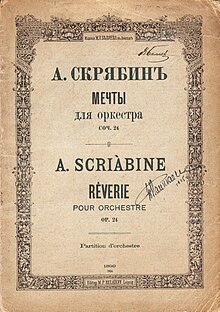Rêverie (Scriabin)
The Rêverie op. 24, composed in 1898, is an orchestral work of only about four minutes by the Russian composer Alexander Nikolajewitsch Scriabin (1872–1915).
Origin and premiere
Scriabin's first purely orchestral work - which, however, was preceded by the Piano Concerto op. 20 and earlier attempts at orchestral composition that remained fragments - was written in 1898, shortly after the composer had received a piano professorship at the Moscow Conservatory . The orchestral piece, written without the knowledge of its patron and publisher Beljajew , was initially entitled "Prelude". Scriabin and Beljajew, however, agreed on the French name "Rêverie" and the Russian title "Mechty" (daydreams). Nikolai Rimsky-Korsakov , who had strongly criticized Scriabin's piano concerto, was so impressed by Rêverie that he had the world premiere on July 5th . / December 17, 1898 greg. as part of a "Russian Symphony Concert" in Saint Petersburg . In March 1899 the work was premiered in Moscow under Vasily Safonov . The piece was well received in both cities. The American premiere took place on December 2, 1900 with the Cincinnati Symphony Orchestra under Frank Van der Stucken .
Cast, playing time and characterization
The score also provides for the following scoring : 2 flutes , 2 oboes , 2 clarinets , 2 bassoons , 4 horns , 2 trumpets , 3 trombones , tuba , timpani and strings .
The performance of the work, which has only 76 bars, is around 4 minutes.
In Rêverie, Scriabin is already proving his instrumental skill. The full orchestra is only used in the first phase of the increase in the piece, which is laid out in two arcs of tension; the thematic events are economically divided between different groups of instruments. The theme sounds first dolce espressivo in the 1st clarinet over tremolos on the 2nd violins and after 8 bars changes to the cellos with counterpoint in the 1st oboe. From bar 17 the violins take over.
The tonal language of the Rêverie in E minor is late romantic chromatic , whereby influences of impressionism become noticeable, with which Scriabin probably came into contact on his European trips in the 1890s, especially to Paris. The structure of the short piece follows the ABA-Coda scheme. The lyrical-melancholy beginning increases to a short, triumphant passage and then returns to the mood at the beginning. A second increase is suddenly interrupted by a general pause and the orchestral miniature closes darkly in the triple piano. The 3-digit meter is often obscured by phrasing across bar lines.
In 1899 the work was published as Alexander Scriabin's op. 24 by the music publisher MP Belaieff . In 1926 the Russian composer Alexander Winkler created a version for piano four hands.
literature
- Igor Fjodorowitsch Belsa: Alexander Nikolajewitsch Scriabin . Verlag Neue Musik, Berlin 1986. ISBN 3-7333-0006-8 , pp. 77/78.
- Sigfried Schibli: Alexander Scriabin and his music . Piper, Munich / Zurich 1983. ISBN 3-492-02759-8 , pp. 207-209.
- Lincoln Ballard, Matthew Bengtson, John Bell Young: The Alexander Scriabin companion: history, performance, and lore . Lanham, Rowman & Littlefield (2017), ISBN 978-1-4422-3261-7 , pp. 81/82.
Web links
- Scriabin: Rêverie : Sheet music and audio files in the International Music Score Library Project
- Work description Hector Bellman with discography, allmusic.com (engl.)
